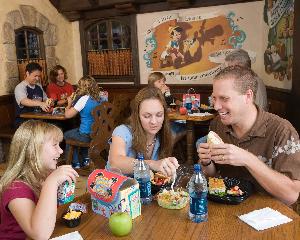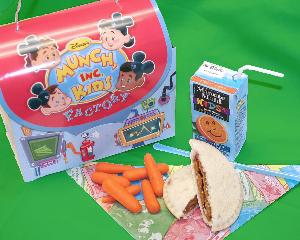- Disneyland
Disneyland Resort, Anaheim California
Disneyland Guide
Pictures
Columns & Reports
News/Events
- Walt Disney World
Walt Disney World, Orlando Florida
WDW Guide
Pictures
News/Events
- Features/News
- Columns
- Int. Parks
International Disney Parks
- About
|
The Walt Disney Company's new food guidelines, which were announced on October 16, are aimed at giving parents and children healthier eating options. The guidelines will govern Disney's business partnerships and activities in the U.S. on a going-forward basis and will be adapted internationally over the next several years. In addition to the efforts at Walt Disney Parks and Resorts, Disney Consumer Products has already begun to offer many licensed products that comply with the guidelines.
Designed to encourage better eating habits with more nutritious side dishes and beverages, the revised kids meals have been available since the beginning of October. They include a beverage choice of low fat milk, 100 percent fruit juice or water and a side dish such as unsweetened applesauce, baby carrots or fresh fruit. "This is a terrific initiative because it makes it easier for parents, even while on vacation, to provide their children with a well-balanced meal with kid appeal," said Jay Rasulo, chairman of Walt Disney Parks and Resorts. "An overwhelming majority of parents tell us they prefer the more nutritious meals for their children over other options." Millions of children's meals were served last year at Disney's 180 restaurants and more than 200 food carts and kiosks. More nutritious side dishes and beverages, which have been available within the parks and resorts for the last three years, are now being offered prominently on menus and in signage as the standard children's meal, rather than as a secondary choice. Guest research conducted last summer at pilot locations in Walt Disney World and the Disneyland Resort, where 20,000 revised kids' meals were served, showed that 77 to 90 percent of the parents, respectively, stayed with fruit or vegetable side options when they were offered first. Recognizing that visits to Disney parks are vacations, parents will still be able to request more indulgent meals and snacks from a wide variety of food offerings.
Out With the Added Trans Fat As part of a pilot program, The ESPN Zone restaurant, located at Downtown Disney in Anaheim, California, and the ABC Commissary at Disney-MGM Studios at Walt Disney World Resort, removed added trans fat from chicken tenders, French fries and frying oils &ndash and the reviews have been good. Guest research conducted at the Downtown Disney ESPN Zone showed that 71 percent of Guests rated the taste of the fries as "excellent" or "very good." "The food & beverage teams at Walt Disney Parks and Resorts want to use our creativity and innovation to partner with parents in making well-balanced meals appealing, accessible, great tasting and fun," said Mary Niven, vice president, Disneyland Resort Food and Beverage. Other New Items on the Menu In addition to removing all added trans fats from foods served in the parks and resorts over the next 12 months, Disney will be constantly looking for ways to improve the nutritional profiles and taste of its most popular entrees, including low fat and vegetarian options. Other changes include
*According to the Food and Drug Administration, "trans fat
is made when manufacturers add hydrogen to vegetable oil, a process
called hydrogenation. Trans fat can be found in vegetable shortenings,
some margarines, crackers, cookies, snack foods, and other foods
made with or fried in partially hydrogenated oils. This process
increases the shelf life and flavor stability of foods that contain
these fats. Like saturated fat and dietary cholesterol, trans fat
raises the risk of heart disease." |
||||
|
|
|
|
|
home
| disneyland
resort | walt
disney world | site map
| site index No part of this website may be reproduced in whole or in part without permission. disneygeek.com is not affiliated with The Walt Disney Company in any way. The official Disney site is available at www.disney.com All Disney parks, attractions, characters, titles, etc. are registered trademarks of The Walt Disney Company. This site provides independent news articles, commentary, editorials, reviews, and guides primarily about the theme parks of the Walt Disney Company.
|


